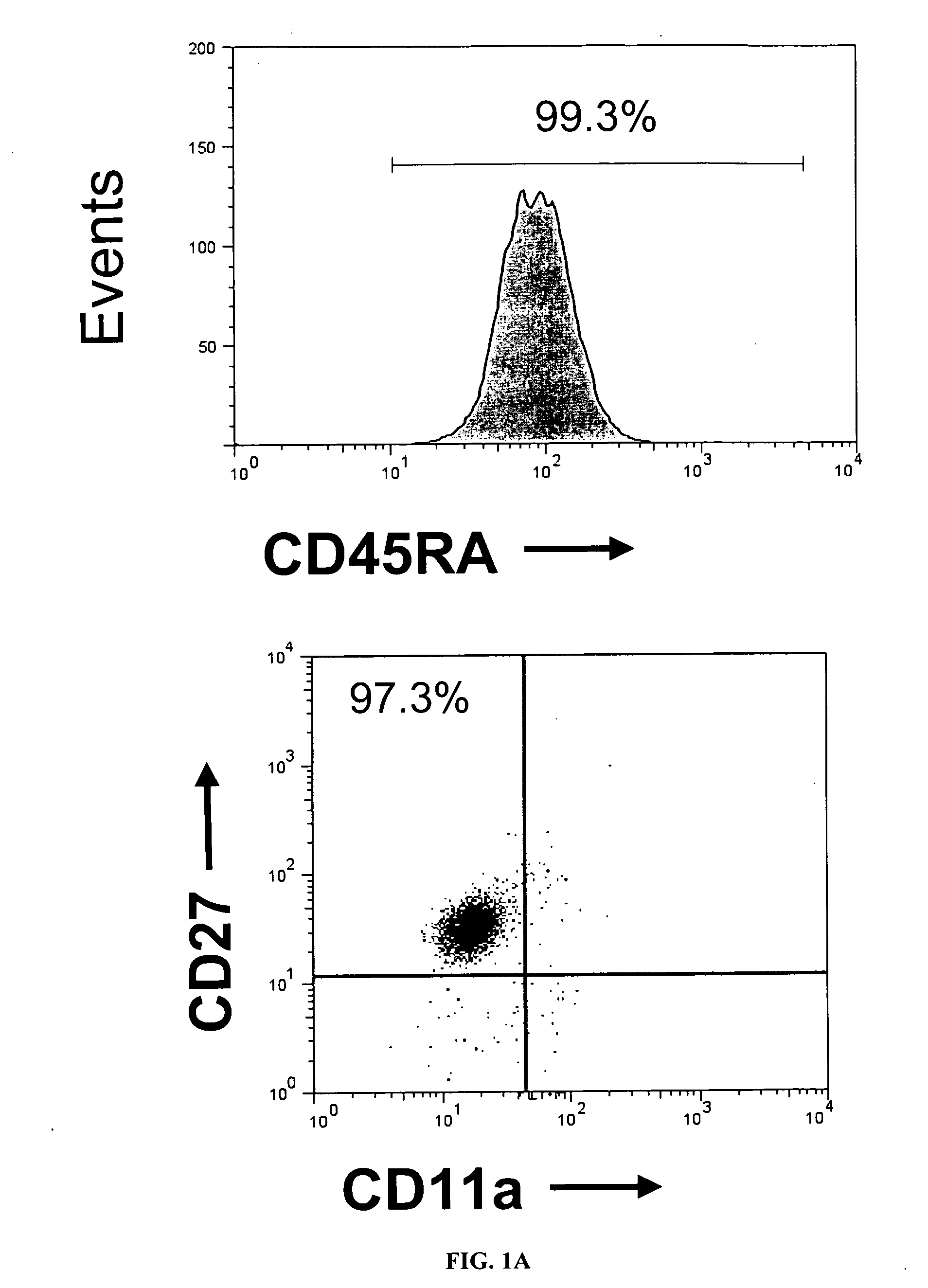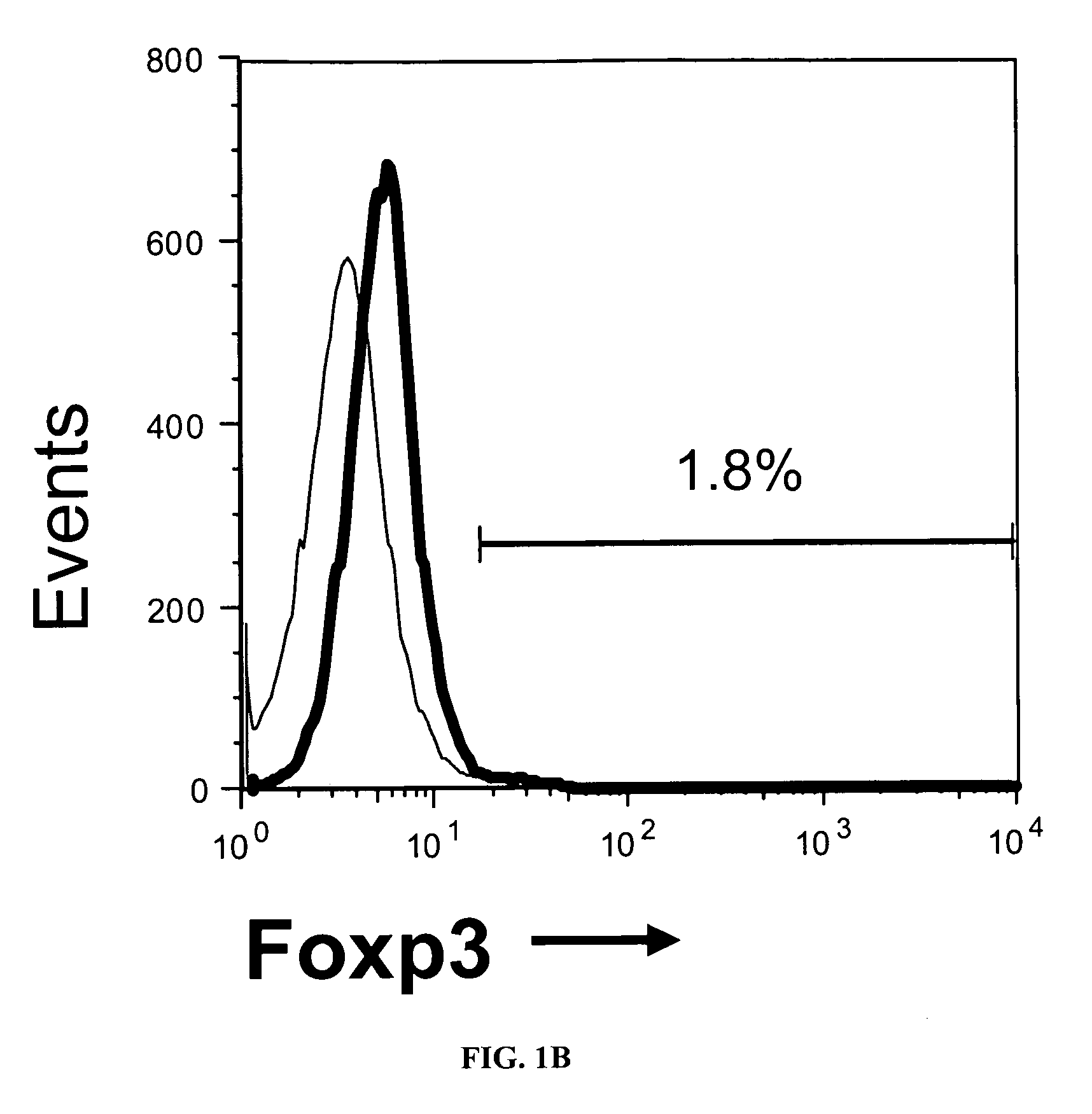Preparation of regulatory t cells using icam-1 co-stimulation
a technology of regulatory t cells and co-stimulation, which is applied in the direction of immunological disorders, drug compositions, biocide, etc., can solve the problems of incomplete central tolerance and need for further immune regulation, and achieve the effect of increasing the quantity of regulatory t cells and facilitating immunotherapy
- Summary
- Abstract
- Description
- Claims
- Application Information
AI Technical Summary
Benefits of technology
Problems solved by technology
Method used
Image
Examples
example 1
Co-Stimulation of Naive T Cells Through ICAM-1 Generated T Cells with a Phenotype Characteristic of Regulatory T Cells
[0066]To analyze the potential function of ICAM-1 in the differentiation of regulatory T cells, human naive CD4+ cells were isolated as shown in FIG. 1(A). These naive CD4+ cells (3×105 cells / well) were stimulated in 96-well plates coated with immobilized antibodies against CD3 and different co-stimulatory molecules. The treatment groups were as follows: (1) Nonstimulated, (2) anti-CD3 alone, (3) anti-CD3 plus anti-ICAM-1, (4) anti-CD3 plus anti-CD11a (LFA-1), and (5) anti-CD3 plus anti-CD28.
[0067]The treated cells were then assessed for the presence of Foxp3. After approximately five days of stimulation using anti-CD3 plus anti-ICAM-1, a cellular subset was detected with a regulatory T cell phenotype expressing the intracellular regulatory T cell marker Foxp3 (FIG. 1(C)), the extracellular regulatory T cell marker CD25 (FIG. 1(D)) and CD127 (FIG. 1(E)). There was no...
example 2
Co-Stimulation of Naive T Cells Through ICAM-1 Generated Regulatory T Cells That Underwent Proliferation
[0068]Studies to determine whether regulatory T cells can proliferate in culture have yielded conflicting results. Thus, this example assesses the proliferation of the regulatory T cell population after co-stimulation through ICAM-1 during the differentiation process. Newly purified naive CD4+ T cells were stained with CFSE and stimulated using the indicated treatment regimens (FIG. 1(F)). After seven days of stimulation, the Foxp3+ population included both undivided cells and cells that had undergone cell division. Even though cells proliferated robustly with co-stimulation through CD28, an appreciable population of Foxp3+ cells was not detected with this stimulation condition. When the kinetics of regulatory T cell induction were analyzed, we observed that the percentage of Foxp3+ regulatory T cells was highest at day 7 of stimulation through CD3 plus ICAM-1 (FIG. 1(G)).
example 3
ICAM-1 Co-Stimulation Resulted in Strong IL-10 Production
[0069]One mechanism of regulatory T cell suppression is the production of the immunosuppressive cytokine IL-10 which functions to inhibit IL-2 production and proliferation of T cells. Thus, cell culture supernatants from naive CD4+ T cells stimulated through CD3 plus ICAM-1 or through CD3 plus CD28 were collected. IL-10 ELISA detected large amounts of IL-10 in supernatants from cells co-stimulated through ICAM-1 (FIG. 2). Interestingly, the concentration of IL-10 peaked on day 7, which corresponds to the day of the highest regulatory T cell percentage in ICAM-1 co-stimulated cultures (FIG. 1(G)). Small amounts of IL-10 were produced by cells co-stimulated through CD28 on days 1 through 5, but no IL-10 was detected after day 5.
PUM
| Property | Measurement | Unit |
|---|---|---|
| pH | aaaaa | aaaaa |
| volume | aaaaa | aaaaa |
| volume | aaaaa | aaaaa |
Abstract
Description
Claims
Application Information
 Login to View More
Login to View More - R&D
- Intellectual Property
- Life Sciences
- Materials
- Tech Scout
- Unparalleled Data Quality
- Higher Quality Content
- 60% Fewer Hallucinations
Browse by: Latest US Patents, China's latest patents, Technical Efficacy Thesaurus, Application Domain, Technology Topic, Popular Technical Reports.
© 2025 PatSnap. All rights reserved.Legal|Privacy policy|Modern Slavery Act Transparency Statement|Sitemap|About US| Contact US: help@patsnap.com



